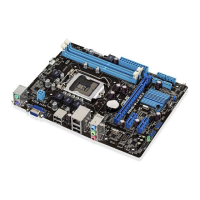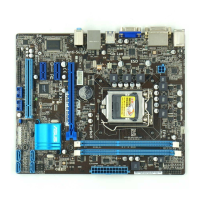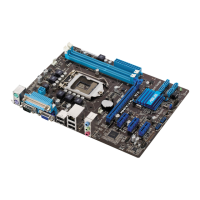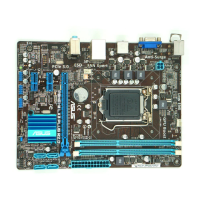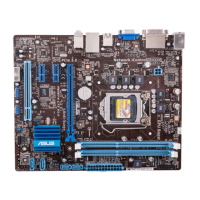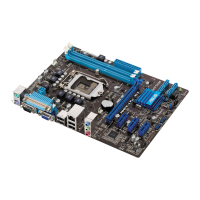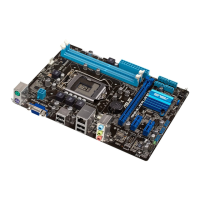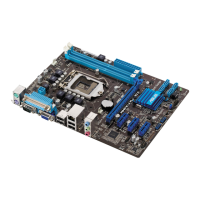
Do you have a question about the Asus P8H61-M LE and is the answer not in the manual?
| Non-ECC | Yes |
|---|---|
| Memory channels | Dual-channel |
| Number of memory slots | 2 |
| Supported memory types | DDR3-SDRAM |
| Maximum internal memory | 16 GB |
| Supported memory clock speeds | 1066, 1333 MHz |
| Processor socket | LGA 1155 (Socket H2) |
| Processor manufacturer | Intel |
| Compatible processor series | Intel Core i3, Intel Core i5, Intel Core i7 |
| Number of COM connectors | 1 |
| Number of SATA II connectors | 4 |
| Number of Parallel ATA connectors | 0 |
| USB 2.0 ports quantity | 6 |
| Audio chip | Realtek ALC887 |
| Component for | PC |
| Power source type | ATX |
| Motherboard chipset | Intel® H61 |
| Audio output channels | 7.1 channels |
| Motherboard form factor | micro ATX |
| Supported storage drive interfaces | SATA II |
| Cables included | SATA |
| Parallel processing technology support | Not supported |
| BIOS type | EFI |
| ACPI version | 2.0a |
| BIOS memory size | 32 Mbit |
| PCI Express slots version | 2.0 |
| Controller interface type | SATA 3Gb/s |
| LAN controller | Realtek RTL8111E |
| Ethernet interface type | Gigabit Ethernet |
| Depth | 203 mm |
|---|---|
| Width | 244 mm |
Details CPU socket type, supported processors, and the Intel H61 Express Chipset.
Outlines memory support (DDR3) and graphics output options including resolutions.
Introduces key features like Intel processors, memory, and I/O capabilities of the motherboard.
Details the Intel H61 chipset and dual-channel DDR3 memory support for enhanced performance.
Explains the benefits of USB 3.0 for faster data transfer and PCIe 2.0 for improved system performance.
User-friendly BIOS interface with easy navigation and performance tuning options.
Features for real-time GPU overclocking and system performance adjustments via TurboV.
Protection against power surges and an integrated software suite for system management.
Power saving technology and intelligent fan speed control for optimal system efficiency and cooling.
Essential precautions to take before installing or removing motherboard components to prevent damage.
Describes the LGA1155 socket and necessary checks before CPU installation, including PnP cap handling.
Step-by-step guide on how to properly install the CPU into the socket, including lever operation.
Instructions for installing the CPU heatsink and fan, including fastener alignment and orientation.
Detailed procedure for safely uninstalling the CPU heatsink and fan assembly from the motherboard.
Explains the two DDR3 DIMM sockets and the characteristics of DDR3 memory modules.
Details on installing DIMMs, memory size mapping, voltage recommendations, and CAS latency.
Step-by-step guide on how to insert a DIMM module into the socket and secure it with retaining clips.
Instructions for safely removing a DIMM module from the motherboard socket.
Covers methods for backing up, managing, and updating the motherboard BIOS.
Instructions for installing and using the ASUS Update utility for BIOS management within Windows.
Step-by-step guide to updating the BIOS directly from a USB flash drive without an OS.
Procedure for recovering a corrupted BIOS using the support DVD or USB drive.
Describes the Advanced Mode for detailed system configuration and the main menu bar items.
Settings for DRAM speed and selecting CPU overclocking modes like Auto or Manual.
Options to configure memory operating frequency and integrated GPU maximum frequency.
Controls for EPU power saving, GPU Boost, and DRAM voltage adjustments.
Configuration for CPU ratio, Enhanced Intel SpeedStep, and Turbo Mode for performance tuning.
Allows setting CPU and iGPU voltages with offset options and risk level indicators.
Settings for DRAM, VCCIO, and CPU PLL voltages, with warnings about high voltage impact.
Displays detected CPU information and allows adjustment of CPU ratio and thermal monitor settings.
Settings for Intel Virtualization Technology and Enhanced Intel SpeedStep Technology.
Configuration for Turbo Mode, CPU C1E, C3, and C6 power states for performance and efficiency.
Configures system behavior after AC power loss and enables wake-up events from PS/2, PCI, PCIe, or RTC.
Allows selection of fan profiles (Standard, Silent, Turbo, Manual) for CPU fan speed control.


